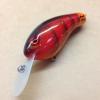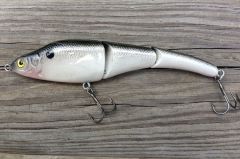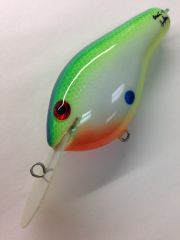-
Posts
140 -
Joined
-
Last visited
-
Days Won
1
Content Type
Profiles
Articles
TU Classifieds
Glossary
Website Links
Forums
Gallery
Store
Everything posted by HAWGFAN
-
Look through your tackle box. What patterns do you like and catch fish on? Many on here use Createx paints. They'll have many of the colors you want, straight from the bottle. Others can be mixed.
-
Here's my opinion... I once tried some WW KOs from a foreign source. I was very excited about this because I live near the Ozarks, and these baits are very popular. Some colors are no longer available, and other guys like to customize. It all sounded like a great opportunity until I made my first cast. They would dive about 6 inches, and at the first sign of a wobble, flip upside down and rocket to the surface. I can't find these blanks anymore, so I assume others had the same issue. They looked great. The body shape, bill dimensions and angle, line tie and ballast position were all but carbon copies of the originals I own. The only glaring difference I could detect was weight. The ballast weights were steel, and not very large. I guess I should have crimped split shots on the belly hook to see if it would eventually swim somewhat correctly to verify this was indeed the problem. All this is to say that as a satisfied Predator Baits customer, I'd vote for lead weights, if I get a vote. I think getting the ballast correct will be more forgiving, and I believe most people will prefer the more muted sound. A silent option would be nice too. Whatever Jim chooses, I'm sure they'll be right before this blank is made available to the general public.
-
My thoughts exactly!
-
Mark, $35.50 + ship would really sting for a dud. My scrap pine sanding blocks are looking better all the time!
-
I've never seen these before, but it might be worth a shot. My wood cranks are made from balsa. I'm a bit concerned that it could tear this softer wood, rather than shave it. For the guys that use harder woods (pine, cedar, basswood, etc.), it could be very effective. I think I'll stick to my homemade radius sanding blocks.
-
If you are making a two-piece bait, put the line tie wire in at an angle and bend it around the back of the bill slot. If not, notch the back of the bill, like Mark suggested.
-
I also mix my own olive with Createx transparent paints, but I go about it a different way. I use (approximately) 1 part dark brow to 3-4 parts leaf green. Sometimes I'll brighten it up a bit with some transparent white. For the back on that pattern, I reduce my dark brown very thin, and add pearl gold or copper
-
Can you be more specific? This pattern can differ greatly from one manufacturer to another. Who's are you trying to copy?
-
I use Createx transparent colors for these type patterns. They should be clear enough, but you can reduce them to be sure. I'm assuming you're airbrushing. It looks like red and orange is all you'll need, besides the shell detail.
-
I'm not sure if I understand your question exactly, but I'll try. Usually with a square bill, the bill is glued in. The line tie hanger is in the body of the bait, just like the hook hangers. Usually you'll want the line tie touching the bill, or just above it.
-
After processing the advice I received, I set out to make my first prototype with the line tie in the bill. I wasn't wanting to make a true "deep" diver, but add a couple feet to my shallow model. I looked at many pictures of others baits, and kind of read between the lines of what was given to me here. What I did know, was that this body does well with 3/4" of bill exposed, set on a 45 degree angle. I didn't want to get too aggressive on my first attempt, so I tried to build some forgiveness into this bait. I used a bill of similar shape and width, and put the line tie 3/4" from the end. I also brought the angle up to only 10 degrees. I left 3/8" space between the line tie and the bait body. It was actually a very successful attempt. I seemed to get at least 2 extra feet of depth, in limited testing. As I expected, the action is also tighter than my shallow model, which I hoped for in a deeper diver. If I use more length beyond the line tie in the future, I believe the 50/50 rule will start to apply. That may be my next endeavor. Thanks again for all the comments. The advice of more experienced builders has definitely helped me to avoid building a lot of hand carved balsa key chains.
-
I use a compressor that is almost identical to yours. Mine is a 3 gallon, from Harbor Freight. You may be surprised how little it has to run to supply your airbrush. I use Createx and Wicked acrylics, as most here do. I do reduce most of my paints a bit. That's not a real scientific ratio, but you'll learn what viscosity works best for you. I typically spray at 30 psi. It's another topic, but you may also find yourself using much lower pressures at times to achieve stippling effects. I also have the moisture trap, as recommended. I've never found moisture in it, but it could save a lot of frustration some day.
-
I've used the suspending version of the vision 110 from Predator with no issues in 50-60 degree water. I use a thin coat of Etex, 6mm split rings, and #6 9651BN (black nickle, short shank) VMC hooks. If they sink, it's so slow that I can't tell, and it doesn't cause any issue.
-
I agree, the bill is too long for where the line tie is. The good news is, they can probably be salvaged. Just trim the bill length, as was already suggested. Just as a guess, they should start to work correctly at around 7/8" of total bill length. A good pair of utility shears should cut your Lexan (I'm assuming that's what you used), then smooth by sanding. If you used plexiglass, you'll have other issues that may show up later.
-
Yeah, you may want to use a bit less. Here's what works for me... Thoroughly mix Etex, Let stand 10 minutes, brush on heavy coat, use end-to-end strokes to completely cover and remove excess (at this point, if the bait has a heavy coat, and so does your brush, wipe the excess off your brush), place on 9 RPM wheel by clamping the bill (bait is perpendicular to axis of rotation). I've heard of a guy that puts the Etex on immediately, hangs, and lets a bit of the excess drip off the tail before putting on the wheel. If you are using way too much, that could help. The only sagging issues I've ever had was with turning off my wheel too soon, and I feel like I use a lot. One more thing. If you are doing flat sided baits, they are far more susceptible to sagging problems. If that's the case, just be careful to use less. After fully cured, sand out the sags, wipe with alcohol, and re-coat.
-
That will help, but it will still flow for up to two hours, in my experience. Another thing that will help, is to use multiple thin coats. I use a drying wheel. This gives it a chance to level, and prevents sags/runs. You can also hang your baits, and turn by hand. You'll have to turn them often for the first hour or so.
-
I've been interested in trying this product myself on my balsa baits. It sounds like a good first step in the seal/undercoat process. After doing a search in this forum you'll find a major concern. It appears some have had issues getting all the solvent out of the wood. This causes bubbling when heat setting your paint. This can be avoided with more curing time I assume, if you're willing to wait, as some do. For me, I've decided to stick with propionate and/or epoxy for sealing. A thin mix of prop penetrates the wood and drys quickly. A thicker solution builds faster. Epoxy does a better job of leveling, and will hide imperfections in the wood easier. It's not a bad idea to use both. Some start with thin super glue for this purpose.
-
You might even experiment with a bit of Chartreuse in the mix that RayburnGuy recommended. I also use the Createx transparent colors. Painting over silver/chrome blades will work best. If you use opaque paints, blade color shouldn't matter.
-
All I can offer is my opinion. I have no knowledge of the manufacturing of commercially available jerkbaits, so here's my 2 cents. Putting a circuit board lip in a molded plastic bait, as opposed to an integral plastic one, would probably add a bit of additional cost and time. Jerkbaits typically don't have a lot of contact with cover, so durability isn't a real issue. The molded lip is clearer as well. That would be the only advantage I see with wood baits, since the bill installation should be essentially the same. As for the square bill...They tend to have a tighter action, as opposed to a similarly sized rounded lip. Since a jerkbait is limited on the size of lip that you can fit in it, the square bill might not give the desired action. Just my opinion, for what it's worth.
-
I have had pretty good luck by taking my baits outdoors to photograph. The natural sunlight gives better color rendering than many indoor lights and camera flashes. My wife is a photographer, and her gear works great, but I don't like setting it up for a shot or two. Outdoors isn't always an option, but try it sometime, if you haven't already. Slightly overcast conditions seem to work the best for me. You'll have less glare and shadows.
-
I've used brushes of various quality, all with good results. A finer, softer brush will put down a smoother coat, but Etex levels nicely. I can't see a difference in the end result with anything I've tried. Other epoxies may be more picky. I clean with an aerosol epoxy stripper available at Wal-Mart. I don't recall the brand. Your brushes will be a lot easier to clean if you don't let the epoxy get near the base of the bristles. It doesn't want to wash out nearly as easy, any will stiffen your brush over time.
-
I have been making balsa crankbaits for a while and have had some pretty good results. So far, everything I've done has had the line tie in the nose of the bait. My next challenge is going to be trying to put the line tie in the bill. I'm hoping some of you can help me shorten the learning curve. I'll assume that the more bill length I have in front of the tie point, the more wobble I'll have. Eventually I suppose you would overpower the bait, and make it unstable. Am I generally correct in this thinking? Next, I have no idea what effect the distance between the body of the bait and the line tie will have. Does it counteract the action gained from the distance between the line tie and the end? If so, I'd guess it would then be a balancing act between the diving depth and action you're trying to achieve. I also understand that the bill angle has a part to play in this equation, so I'm just asking for general "rules of thumb" type comments.
-
I almost hate to resurrect this old thread, but my replacement parts finally came in and I wanted to give an update. After trying the obvious things (cleaning, beeswax) to cure the bubbling paint cup issues on my Neo CN with no success, the new tip did the trick. For good measure, I replaced the needle as well. I now know to be very gentle when seating the needle, or you can flare your tip. I couldn't make bubbles appear, even with water. I had almost forgotten how much more enjoyable it is to paint with a properly functioning airbrush. I had quite a wait to get the new parts. I admit I only tried from one source, but I hope this isn't going to be an issue with the Neo.






